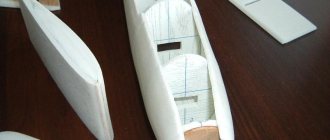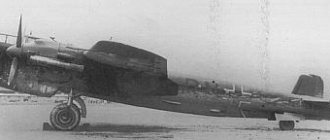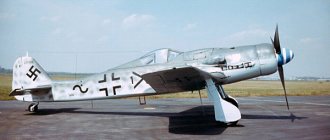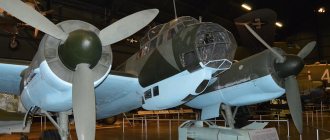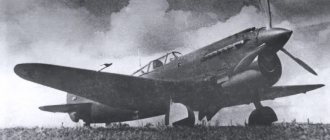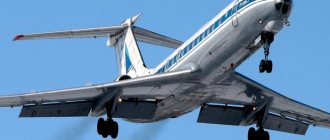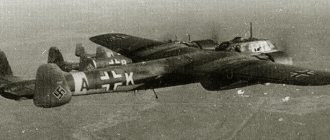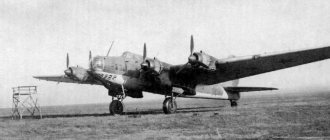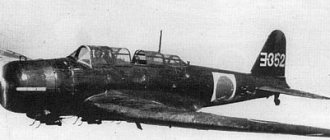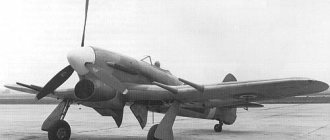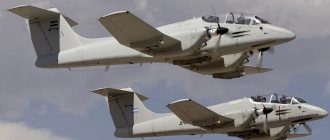What kind of nicknames were awarded to the famous Il-2 attack aircraft. He was both a “flying tank” and a “black death”. But, despite this recognition of its effectiveness, it was far from a perfect aircraft. And not all the designers’ miscalculations could be corrected during modernization. At the same time, the need to replace the Il-2 threatened to slow down the production rate of one of the aircraft most needed by the front.
Only in 1944 was it possible to begin production of a new attack aircraft, in which the shortcomings of its predecessor had to be eliminated. It was the Il-10, which made its way to the assembly line in competition with the attack aircraft developed by the Sukhoi Design Bureau.
The history of the creation of the Il-10 attack aircraft
The Il-2, used by the USSR army, managed to perform well in combat operations, but it had a number of shortcomings that made it vulnerable. Despite the armored hull and the presence of an air gunner, protecting the aircraft from small-caliber bullets and attacks from fighters, the risk of destruction under anti-aircraft fire was extremely high.
The strike force of the Il-2 also did not have good performance, since it could not carry large-caliber bombs, and the suspension of small-caliber bombs did not provide a full combat load. Therefore, the question arose about creating a new attack aircraft that would give an advantage to Soviet troops in the sky.
Initially, it was planned to construct two aircraft at once. The first was supposed to receive similar weapons and replace the IL-2. The second was planned to be a heavy attack bomber with increased armor thickness and enhanced weapons. P. Sukhoi began to create the first one and by 1942 he presented a prototype of the Su-6.
In parallel with this, S. Ilyushin began to think about improving the existing Il-2. Both aircraft were to be equipped with the M-71 engine, but its installation required more time. Therefore, S. Ilyushin paid attention to the AM-42, which became an improved version of the AM-38 used in the Il-2, and began developing his own light attack aircraft. During the design, he drew on experience with the previous aircraft and focused on increasing survivability and combat power.
In 1943, the USSR Air Force decided to give preference to the development of Sukhoi, adopting the Su-6. The aircraft were supposed to begin entering service by 1944. But the People's Commissar for the Aviation Industry noted the high risk of disruption to the production of Il-2 and aircraft engines when starting production of aircraft developed from scratch and having nothing in common with old machines. Therefore, they did not abandon Ilyushin’s project. But the idea of creating a bomber faded into the background, and all attention was focused on attack aircraft.
In the spring of 1944, both aircraft entered comparative tests. The Su-6 was supposed to fly on the M-71 engine, but received an AM-42 for testing, which negatively affected its performance. It showed average results, being inferior in many respects to Ilyushin’s design, which even then received the name Il 10. Therefore, the choice was made in favor of the latter. Its tests were successfully completed in just one month, and the technical characteristics were much higher than expected. The attack aircraft immediately went onto the assembly line for mass production.
On the brink of war
The idea of using aircraft to attack ground targets was not new. Back in the First World War, fighters, as well as a new type of aircraft - bombers - actively attacked enemy positions and rear targets. With the passage of time and the development of anti-aircraft artillery and fighter aircraft, aircraft of a special design were required for sorties to the front line and near the enemy’s front line. Adapting a fighter or bomber for these purposes no longer provided protection from dense anti-aircraft fire and freely hunting fighters. Thus, specialized vehicles began to appear in the armies, used in military aviation even today - attack aircraft. The USSR already had experience in using “militants” (as we called attack aircraft in the 30s), for example R-5Sh or R-Z. But these were precisely the aircraft adapted for these purposes. A revolution in the design of attack aircraft was made by the prototype of our brilliant aircraft designer Sergei Vladimirovich Ilyushin, which was called BS-2 (armored attack aircraft), or TsKB-55, taken into the air on October 2, 1939 by another legend of domestic aviation, test pilot Vladimir Kokkinaki.
BSh-2 attack aircraft prototype
The design of the new aircraft was amazing. For those years it was truly a breakthrough aircraft. The controls, engine and tail were built around the two-seat armored capsule cabin, which could withstand being hit by a 7.62 mm bullet from any distance. Tanks, cisterns, and the main vital components of the aircraft were also armored. Thus, the team of the Design Bureau of Plant No. 39 fulfilled the task of the military and Stalin personally to design a new attack aircraft, invulnerable to fire from the ground. Nevertheless, the new vehicle had a number of shortcomings, primarily related to the engine: the AM-34, even in its forced version, was weak in “pulling” the new heavy vehicle, and the new AM-35 was generally unfinished and performed poorly.
Nevertheless, the military received the new aircraft favorably and, as usual, ordered it to be modified. So, on October 12, 1940, TsKB-57, an “added” version of the BSh-2, took off. The new powerful low-altitude “engine” AM-38 pulled the lightweight car well. But here lay the first drawback - unfortunately, it cost the lives of many pilots. It is not known for certain why Ilyushin did this, but coupled with an increase in the power of the weapon (two 23-mm VYa cannons were added, replacing two of the four machine guns with them) and the new engine, the rear cockpit for the gunner disappeared. The plane became single-seat. Probably, this decision was influenced by deadlines that could not be missed, and work on the DB-3, another project, but this time a bomber, by Ilyushin (by the way, he was the first to bomb Berlin).
Combat use
The pace of production, launched after the aircraft was put into service, was very high. The Il-10 immediately began to be delivered to the air force, but the pilots needed special retraining that could teach them to fly the new attack aircraft and accurately carry out assigned tasks. Therefore, the formation of regiments was somewhat slow. By 1945, only two were fully operational: the 571st and the 108th.
The aircraft were used for air combat only on May 8, 1945, where they were able to show their best side. Before this, they were actively used to perform other tasks, including the destruction of enemy ground targets. Enemy air attacks at this moment were repelled by escort aircraft, but sometimes Il-10s also did this. The most active day for the use of attack aircraft was April 30, when the 571st Regiment flew 115 combat missions.
Within a month, the planes were so worn out that they became unsuitable for further operation. Therefore, flights on them were suspended. During the war, only one Il-10 was lost during an attack by an enemy Fw.190. The planes were later replaced with new ones. Some went to the Pacific Fleet to participate in the war with Japan.
The model became the main combat aviation power in the USSR and all nearby countries. After World War II, it was actively used during the Korean War and participated in Chinese military operations aimed at fighting Japan. The Il-10 remained in service with the USSR until 1956, and was used by other countries until the end of the 1960s.
Are you interested in the history of the Il-10 attack aircraft?
Not really
Tests
The development of the new attack aircraft was carried out at a rapid pace, and the continuity of the design with the Il-10 would allow the Il-16 to be quickly launched into series. The prototype made its first flight in early 1945 under the control of Vladimir Kokkinaki. And it immediately became clear that the aircraft needed significant fine-tuning. The combination of a short tail and a powerful engine led to instability of the car.
A new tail of greater length was made for the aircraft, with a larger surface area. In this form, the attack aircraft became more stable, while showing the ability to perform all aerobatics, and reached a speed of over 570 km/h. However, firstly, it was obvious that he would no longer make it to the front, and secondly, defects in the AM-43 engine were revealed.
The era of jet aircraft was coming and there was no longer any hope that a piston attack aircraft would be able to conduct an air battle with them.
Description of design
The IL-10 was an all-metal single-engine low-wing aircraft. Its fuselage was divided into an armored hull and a tail section. The base was covered with armor of varying thicknesses, ranging from 4 to 8 mm. The skin along the fuselage was overlapped and attached to stringers with a load-bearing frame. The tail part had an oval cross-section and was made of metal. It was fastened to the armored hull using a special square. The tail spinner, which completed the rear part of the hull, consisted of light profiles and duralumin sheets. The tail was cantilevered with a metal stabilizer.
The wing is two-spar, trapezoidal in shape. It consisted of a center section and two parts of consoles. With the help of special fairings, the transition from the fuselage to the wing was made smooth. The ailerons had fabric covering and were covered with a special material. The Schrenk-type takeoff and landing flaps included three sections. The landing gear belonged to the three-post category and was retractable during flight. It was installed at the ends of the center section. The tail wheel was also hidden inside the body when taking off from the ground.
The AM-42 engine developed power up to 2000 hp. With. It was installed on duralumin semi-frames mounted on an armored hull. The first fuel tank was located immediately behind it. The second was mounted under the cabin floor. The oil radiator was installed in the armored compartment of the left wing. The seat for the pilot and gunner is protected by 64 mm thick armored glass. A fire protection and ventilation system was installed inside. The gunner's cockpit had a special machine gun to repel enemy air attacks.
Flight and technical characteristics
Dimensions are standard for an attack aircraft of that period. The length was 11.12 m with a height of 4.18 m. The wing area was 30 m², and its span reached 13.4 m. The aircraft crew consisted of two people.
The empty weight of the Il-10 was 4650 kg; when armed, it increased to 6300 kg. The maximum load for takeoff was considered to be 6537 kg. Technical performance was provided by the AM-42 engine, producing up to 2000 hp. With.
The plane could accelerate to 551 km/h, and its cruising speed was limited to 436 km/h. The rate of climb reached 625 m/min. The flight range was 1520 km, the combat radius freezes at around 800 km. The practical ceiling is 7250 km. For takeoff, the Il-10 required a run of 475 m, and for landing - a run of up to 460 m.
Tests
The development of the new attack aircraft was carried out at a rapid pace, and the continuity of the design with the Il-10 would allow the Il-16 to be quickly launched into series. The prototype made its first flight in early 1945 under the control of Vladimir Kokkinaki. And it immediately became clear that the aircraft needed significant fine-tuning. The combination of a short tail and a powerful engine led to instability of the car.
A new tail of greater length was made for the aircraft, with a larger surface area. In this form, the attack aircraft became more stable, while showing the ability to perform all aerobatics, and reached a speed of over 570 km/h. However, firstly, it was obvious that he would no longer make it to the front, and secondly, defects in the AM-43 engine were revealed.
The era of jet aircraft was coming and there was no longer any hope that a piston attack aircraft would be able to conduct an air battle with them.
Modifications
The basic model was released in 1944, but by 1945 the first modified versions were introduced. They were distinguished by improved characteristics and main purpose.
A total of 4 modifications were released:
- IL-10 “Cannon” - the model received enhanced artillery armament, presented in the form of four NS-23 cannons, a BT-20 installation, bombs and rocket shells;
- Il-10U is a training version of the aircraft, it was intended for training attack aircraft pilots, the gunner’s cockpit was replaced with a special compartment for the instructor, and part of the armor and weapons were also removed from the vehicle;
- Il-10M - the second military modified version of the Il-10 was created for use in the Korean War, the aircraft became slightly larger and received improved on-board equipment for flights in difficult conditions;
- Avia B-33 - the last modified model was produced by Czechoslovakia after it received the appropriate license, was similar to the version from the USSR and was distributed among the ATS countries.
In total, about ten thousand Il-10 aircraft were produced in various modifications. After the end of their service, most of them were written off and sent to storage or disassembled for spare parts.
Are you here
Home » Blog » Other » IL-16 2015-04-12
Others
IL-16
The Il-16 attack aircraft is a further development of the famous Il-10 aircraft. The most noticeable differences between these machines will be that the new machine is one meter shorter than its predecessor. The aircraft was designed in 1945 by the Ilyushin design bureau. The aircraft's power plant consisted of two AM-43NV type engines. These engines could develop a power of 2.3 thousand horsepower. The vehicle had weapons similar to those of the Il-2 aircraft. The maximum speed of the car was 576 km/h. Despite everything, it never made it into mass production. This could mainly be attributed to persistent technical problems. The greatest problems were associated with the propeller-motor system. Serial production was also canceled due to the uselessness of this aircraft, since the war was over.
Design features of the Il-16 attack aircraft
The Il-10 model aircraft was the standard of Soviet attack aircraft during the Second World War, which is why a new aircraft was developed on its basis, which should achieve even better flight characteristics. After the completion of state tests of the Il-10, the design of the new Il-16 began.
For the new aircraft, a more powerful engine was manufactured in the design bureau of A. Mikulin. In terms of design and aerodynamic characteristics, the IL-16 was very similar to the original vehicle. The difference was lower mass and some geometric parameters. Due to all this, the attack aircraft was supposed to reach speeds of up to 625 km/h. In addition, the robust design and high thrust-to-weight ratio should have made it possible to perform even the most complex aerobatic maneuvers. The plane had armor that repeated all the shapes of the previous model, the difference being the thickness of the armor itself. On the Il-16, the armor was thinner, which made it possible to reduce the overall weight of the structure. At the same time, the area of the aircraft, which did not have armor, was increased.
IL-16 video
The armament was represented by two large-caliber cannons of the NS-23 type. These installations could fire 280 salvos. The armament included two ShKAS model machine guns, with which an ammunition load of 1,400 rounds was installed. All weapons are placed on detachable parts of the wings. The maximum bomb load of the vehicle was 400 kilograms. The bombs were placed in the internal compartment of the aircraft. In addition, bombs could be mounted on an external sling. With further modifications to the device, the bomb load was increased to 500 kilograms. The tail section of the vehicle was protected by a UB-20 type cannon, which had 150 rounds of ammunition. To protect against the enemy, the Il-16 carried AG-2 class aircraft grenades.
Despite the fact that the weapons of the new and old attack aircraft were identical, the Il-16 had many advantages due to its speed and maneuverability. At that time, just such an apparatus was not enough at the front. After this, this project began to be prepared for serial production.
The first full-fledged IL-16 was created at the beginning of 45 at a serial plant. During its first flight, the aircraft was piloted by experienced tester V.K. Kokkinaki. This flight showed that with high power and a relatively short fuselage, the machine is difficult to maintain in level flight. To solve this problem, the designers lengthened the tail section by half a meter and increased the total area of the tail, and trimmers were added to the control rudders. With improved aerodynamics, the aircraft also needed modifications to the power plant. Ultimately, the car was never finalized, since this project was closed in the middle of the summer of 1946.
Armament of IL-10
In terms of armament, the Il-10 was superior to many foreign analogues. On its wings were mounted two NS-23 cannons with 150 rounds for each and a pair of ShKAS machine guns of 7.62 mm caliber with a total supply of 1,500 rounds. The shooter used different weapons. Its cabin was equipped with a 12.7 mm UBT machine gun with a reserve of 190 rounds. Aiming assistance was provided by the PBP-1b collimator sight. In the new modifications, four 23 mm NS-23 machine guns were installed on the wings, and a 20 mm UB-20 cannon was installed on the shooter.
Small-caliber bombs were loaded inside special compartments, large-caliber bombs were suspended on external installations. The use of up to 182 small bombs and up to two large FAB-250s was allowed. The Il-10 also had four beams for unguided missiles, each of which was equipped with two RS-82 or RS-132. In the tail section there was a cartridge with ten fragmentation grenades for protection against attack by fighters from behind. The total combat load was limited to 600 kg.
The IL-10 became one of the most advanced aviation projects of the Second World War. Good technical characteristics and successful operating experience have proven this. The aircraft was used for almost 15 years by many countries; now surviving examples can be found in the form of monuments or museum exhibits.
About operation
Supplies of Vilayet-28 to the People's Republic of China were established. Soon in the PRC, local designers mastered the economy and began producing similar aircraft at the plant in Harbin, such as the H-5. Six such aircraft units were purchased from China by Romania. Finland also purchased Il-28 from Sovok, where 4 bombers were used to tow targets. In 1955, 30 Soviet aircraft were delivered to the Land of the Pyramids. Operating countries include Algeria, Bulgaria, Czechoslovakia, East Germany, Vietnam, North Korea, Yemen, Morocco, Cuba, Somalia, Syria, Indonesia and Nigeria. Enough for the eyes The Il-28 was successfully used in mountainous areas in Afghanistan. In the Soviet Union itself, the maize plant was not used for long.
At the end of the 1950s. they began to replace him with the Yak-28. The IL-28 was written off and disposed of, according to eyewitnesses, in the most barbaric way: trampled underfoot using tractors and bulldozers. A bunch of planes were converted into training ones. Some IL-28s until the 1980s. were used as target towing vehicles.
